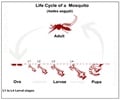SIR-Network Model - new mathematical model offers a simplified approach to studying the spread of dengue fever in urban areas.

‘Susceptible-Infected-Recovered (SIR)-Network Model can help predict the dengue fever epidemic in the urban areas’





"The SIR-Network model can be used to predict whether local interventions -- like cleaning up standing water in containers -- in one or two neighborhoods could affect the prevalence of Dengue across the city," says coauthor Daniel Coombs. "We give formulae that describe whether an epidemic is possible, in terms of human travel patterns among neighborhoods, mosquito populations and biting rates in each neighborhood." The model uses a Susceptible- Infected- Recovered (SIR) approach to disease spread and the network consists of the city's neighborhoods where local populations are assumed to be well-mixed. The fraction of people traveling from residential neighborhoods to active ones are represented by directed edges in the network. The article also presents fundamental properties of the basic reproduction number (Ro) for their specific model. Ro is the expected number of secondary cases due to a single infection. The group focuses on how Ro depends upon geometry and heterogeneity -- different infection rates in each vertex -- of the complex network.
In the second part of the article, the authors applied the SIR-Network model to Dengue fever data, which had been updated several times, including as recent as 2014, from the epidemic outbreak of 2007-2008 in various neighborhoods of Rio de Janeiro, Brazil, and soon discovered several interesting features of the epidemic.
First, they needed to include a transmission rate that varied over the months of the Dengue season to match the available data. The authors predict that the transmission rate peaks 6-8 weeks before the peak incidence of Dengue.
Secondly, they predict that the city center, where large populations from various neighborhoods go to work each day, is the most important neighborhood to spreading the fever. Ultimately, the researchers found that results were improved most when a time-infection parameter was introduced to model seasonal climate changes.
Advertisement
The coauthors admit establishing a comprehensive picture of Dengue would be very challenging because there are so many varying pieces to the puzzle. For example, some of the factors to be considered include the impact of environmental variables on mosquito populations, changes in weather, human behavior like mosquito avoidance or control and travel on the network.
Advertisement
The SIR-Network Model offers researchers a simplified and clearer image of the bigger picture of Dengue fever, and has the potential to help quell the disease (as well as be applied to other disease spread issues), saving lives, time and money.
Source-Eurekalert














